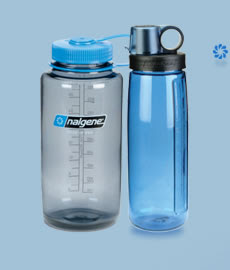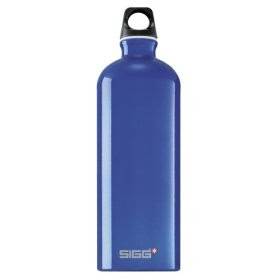The Nalgene Controversy
 These bottles have been sitting in the Hotlist's Top Ten for months. Read up on the love Nalgene is getting from our members.
These bottles have been sitting in the Hotlist's Top Ten for months. Read up on the love Nalgene is getting from our members. We've been chatting in our site forum recently about Vancouver-based Mountain Equipment Co-op's (a.k.a. MEC) decision to yank some of the popular Nalgene water bottles from its shelves. So far, MEC is the only major retailer to do so. The action only applies to products that contain bisphenol-A (BPA).
BPA is an estrogen mimic that can interfere with your body's hormone balance. Hormone mimics in general can cause a variety of problems, including certain cancers, reduced fertility (especially in men), early onset of puberty (especially in girls), birth defects, and reproductive system diseases. These effects are often only seen over long-term exposure.
Many governmental health bodies (e.g. EPA) have assessed the dangers of BPA exposure in products like the Nalgene bottles, and concluded that the amount of contamination in humans is below established tolerance levels. Test animals show higher levels of contamination because of their smaller size compared to humans.
However, there has been enough of a kerfuffle about it that Canada's health bureau (Health Canada) has decided to revisit the question and will be publishing their report in 2009. Environmentalists have praised this move. Their position is simple: contaminants of all kinds will eventually have some negative effect on our bodies.
And so the buck is passed back to you. Do you throw out your BPA-containing bottles and switch to another brand? Or do you shrug your shoulders, figuring that everything we wear, eat, drink, and breathe is contaminated in some way anyway?
BPA is an estrogen mimic that can interfere with your body's hormone balance. Hormone mimics in general can cause a variety of problems, including certain cancers, reduced fertility (especially in men), early onset of puberty (especially in girls), birth defects, and reproductive system diseases. These effects are often only seen over long-term exposure.
Many governmental health bodies (e.g. EPA) have assessed the dangers of BPA exposure in products like the Nalgene bottles, and concluded that the amount of contamination in humans is below established tolerance levels. Test animals show higher levels of contamination because of their smaller size compared to humans.
However, there has been enough of a kerfuffle about it that Canada's health bureau (Health Canada) has decided to revisit the question and will be publishing their report in 2009. Environmentalists have praised this move. Their position is simple: contaminants of all kinds will eventually have some negative effect on our bodies.
And so the buck is passed back to you. Do you throw out your BPA-containing bottles and switch to another brand? Or do you shrug your shoulders, figuring that everything we wear, eat, drink, and breathe is contaminated in some way anyway?
Educate yourself from a variety of sources and read Nalgene's statement about BPA safety. Watch for Health Canada's report coming in 2009.










